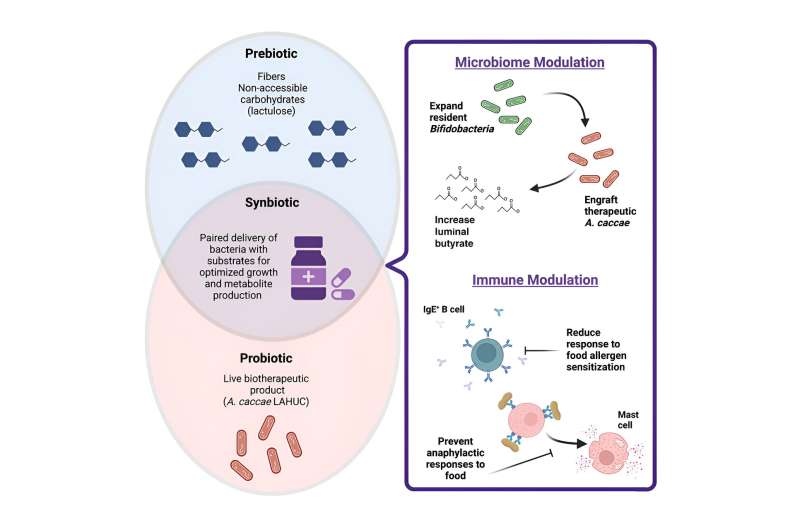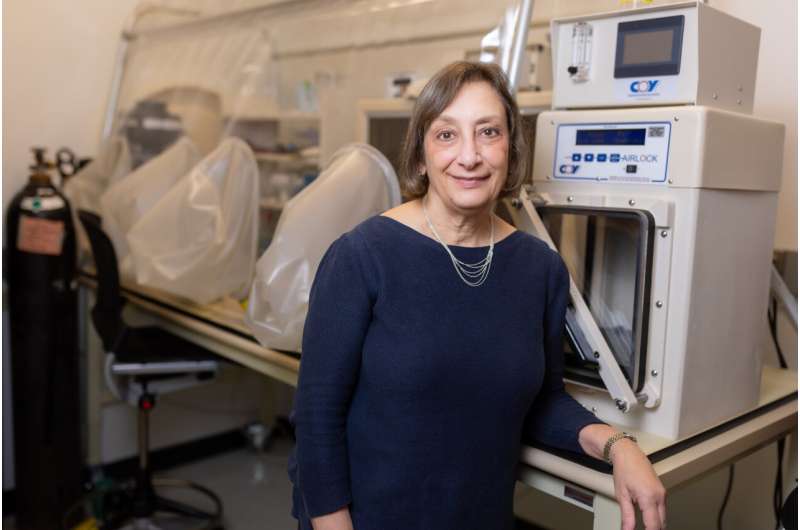This article has been reviewed according to Science X's editorial process and policies. Editors have highlighted the following attributes while ensuring the content's credibility:
fact-checked
peer-reviewed publication
trusted source
proofread
How a microbe and a prebiotic work together against food allergies

What causes food allergies to develop? There's compelling evidence that suggests imbalances of the gut microbiome could be to blame, creating inflammation of the intestinal tract and a gut environment that's prone to food allergies.
Now, new research from Cathryn Nagler's lab at the University of Chicago Biological Sciences Division (BSD) and Pritzker School of Molecular Engineering (PME) reveals a mutually beneficial relationship between an unassuming microbial species and the prebiotic lactulose—together, they encourage the production of an important metabolite known for its positive influence on gut health, butyrate, that's generated as bacteria feed in the gut.
"Butyrate is a four-carbon molecule that has huge effects in the gut… this could have broad impacts for food allergies," said Nagler, Bunning Family Professor, because it could pave the way to development of a synbiotic therapeutic that "addresses dysbiosis of the microbiome, rather than treating the response to an individual allergen."
In a paper published in Cell Host and Microbe, Nagler's lab reports that treatment with a concoction of A. caccae and the prebiotic lactulose increased butyrate levels in the intestinal tracts of mice, stifling allergic responses to cow's milk.
"We know [from scientific literature] that butyrate can improve barrier integrity [of the intestinal tract] and induce broad anti-inflammatory effects," said Ande Hesser, first author of the paper and a former Ph.D. student in Nagler's lab. The body, however, can't produce butyrate on its own—it needs the help of the gut microbiome.
"The primary goal of gut microbiota is to digest dietary fiber, which humans don't have the capacity to break down themselves," Nagler said. "Instead, humans have co-evolved to rely on bacteria to do this job and to produce key metabolites through fermentation—like butyrate—that prevent inflammation and enhance overall gut health."
The modern world has presented new challenges for this long-standing partnership between gut microbiomes and their human hosts.
"Humans acquire their gut microbiome from the environment around them, but compared to much of human history, today we are living in environments that don't contribute to the diversity of the gut microbiome," Nagler said.
Antibiotic use, high-fat and low-fiber diets, decreased exposure to infectious agents, cesarean births, and formula feeding could also be decreasing gut microbiome diversity, resulting in an imbalance compared to humans' evolutionary past.

Putting the puzzle pieces together
Their latest findings build on previous research from Nagler's (published in Nature Medicine) that revealed A. caccae, a potent producer of butyrate, was more abundant in the gut microbiomes of healthy infants compared to infants with cow's milk allergy (CMA) and significantly associated with changes in gene expression in a layer of cells lining the intestines, known as the intestinal epithelium.
That hint about A. caccae's significance in providing allergy protection was a surprising finding given that A. caccae only makes up about 1% of the typical gut microbiome in terms of its abundance.
The team set out to drill down into A. caccae's role on a molecular level, which would require isolating A. caccae and culturing it in the lab. No easy feat considering its low abundance in the microbiome and that it can only survive in completely oxygen-derived environments. "It's quite difficult to work with," Nagler said.
But they were eager to understand the outsized effect A. caccae might have on overall butyrate production in the gut. Hesser, who was pursuing a Ph.D. in molecular engineering in Nagler's lab at the time of this research, seized the challenge. Working with a fecal sample from a healthy infant, Hesser systematically depleted competing species within the sample and screened for A. caccae.
After successfully isolating, genetically profiling a novel strain (which the team named LAHUC for Hesser's initials and University of Chicago), and culturing the strain in an anaerobic chamber, the team set out to see if this strain could colonize a model of cow's milk allergy in gnotobiotic mice, which are born germ-free and then engrafted with certain microbes to enable research.
Partnering with the University's Gnotobiotic Mouse Facility, they first developed a model of cow's milk allergy by colonizing mice with donor feces from an infant with cow's milk allergy.
One week later, some of the mice were fed A. caccae LAHUC while others were fed a sterile control. It's uncommon for a new strain to survive engraftment in a host, so Nagler, Hesser, and their collaborators were pleased to observe that A. caccae thrived and increased in abundance for up to one month after treatment.
But there was no discernable effect on butyrate levels. Hesser and Nagler wondered if the CMA mouse microbiome could be missing a key element required for A. caccae thrive, cross-feed with other bacteria, and ultimately produce butyrate. A prebiotic, perhaps?
A synbiotic combination that halts food allergies
In a lab culture, Hesser screened more than dozen prebiotics to see what, if anything, might help A. caccae trigger butyrate production in the presence of other fecal bacteria species. Prebiotic after prebiotic, there was no payoff in butyrate production.
Finally, when the synthetic sugar lactulose was added, butyrate production took off. Moving the combination into their mouse model of cow's milk allergy, the team administered a mix of A. caccae plus lactulose and saw that butyrate production increased and blunted allergic reactions to cow's milk.
"The field [of microbiome research] sometimes focuses on the presence or absence of bacteria, but we've found that functionality matters. It matters more what they are doing rather than if they are just there," Hesser said. "Only when we added in that [lactulose] prebiotic did A. caccae exert the function we wanted it to."
While the first set of experiments in mice delivered the therapeutic dosages via feeding tube, Hesser also developed and tested out a freeze-dried preparation demonstrating it was just as effective. To translate such a therapeutic to humans, ease of use will be key.
More information: Lauren A. Hesser et al, A synbiotic of Anaerostipes caccae and lactulose prevents and treats food allergy in mice, Cell Host & Microbe (2024). DOI: 10.1016/j.chom.2024.05.019

















